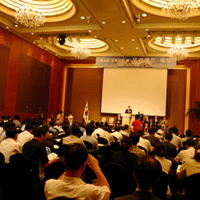
Korea Institute of Ocean Science and Technology (KIOST)
Location:
Ansan, Korea
Partnership Established:
1998
Nature of the Partnership
The Korea Institute of Ocean Science and Technology (established in 1973 as the Korea Ocean Research and Development Institute) plays a crucial role in researching and developing ocean science and technology as the need arises from government policy to keep up with developing ocean industry trends. The mission of KIOST is to perform basic and applied research in order to promote the efficient use of coastal and ocean resources; to undertake a comprehensive survey and study of Korea's seas and open oceans; to conduct scientific research in polar regions, especially in Antarctica; to support and cooperate with other government agencies, universities and private industries towards the development of marine resources and the protection of the ocean environment; and to coordinate international cooperation concerning oceanographic research projects.
KIOST is made up of the following divisions: Physical Oceanography, Marine Chemistry, Biological oceanography, Marine Geology and Geophysics, Polar Research Center, Deepsea Resources Research Center, Coastal and Harbor Engineering Research Center, and Changmok Marine Station.
Director of the Institute Dr. Jae-Hac Lee—an expert in tidal flats, wetlands, and benthic ecology—visited VIMS in 1999, working with scientists in several departments. "In South Korea," says Lee, "the expansive intertidal mudflats are highly productive and economically valuable. However, the ecosystems are under enormous pressure due to encroaching development." Mud flats and sandy bottom environments in Chesapeake Bay share many characteristics with comparable areas in South Korea. Intertidal flats in South Korea are harvested extensively for algae, clams, and worms and represent one of the most productive, natural marine resources in Korea. Run-off and associated pollutants are major concerns. "The problems and challenges are enormous in relation to our land size," explains Lee. While South Korea and Virginia are similar in size, South Korea supports a population of approximately 44 million as compared to Virginia's population of 4 million.
In 1998, Dr. Richard Wetzel of VIMS visited KORDI. Working in collaboration with Dr. Lee and other KORDI scientists, Wetzel and others at VIMS are developing a conceptual ecosystem model for tidal flats in the western region of Korea. VIMS scientists will develop the mathematical model while Korean scientists provide ecological data. "We have much to learn from our colleagues at KORDI," said Wetzel, "South Korea has a long history in the utilization as well as the need to conserve marine habitats because as a nation they are so dependant on the resources of the sea and tidal flats."
